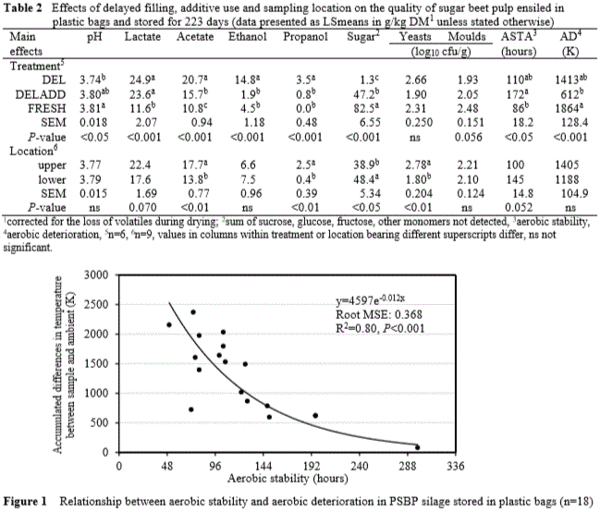Effects of Delayed Filling and Additive Use on the Quality of Pressed Sugar Beet Pulp Ensiled in Plastic Bags
Published: July 7, 2017
By: AUERBACH, H. 1, WEBER, G. 2, NADEAU, E. 3., WEBER, U. 2, WEISS, K. 4, POTTHAST, C. 5*.
/ 1 International Silage Consultancy, Wettin-Löbejün, Germany; 2 BAG Budissa Agroservice GmbH, Malschwitz, Germany; 3 Swedish University of Agricultural Sciences, Department of Animal Environment and Health, Länghem, Sweden; 4 Humboldt Universität zu Berlin, Faculty of Life Sciences, Berlin, Germany; 5 Südzucker AG, Mannheim, Germany. *Now with Agromed.
Introduction
Pressed sugar beet pulp (PSBP) is frequently ensiled in plastic bags and represent a valuable feed component of feed rations for ruminants. However, its high susceptibility to fungal infestation during feed-out, especially in summer, often results in low stability and poor hygienic quality (Kalzendorf, 2007). Therefore, especially the use of chemical additives containing salts of sorbic, benzoic and and/or propionic acids, has attracted significant attention in order to control fungal growth (Weber et al., 2006b; Potthast et al., 2014). In the sugar beet processing season, PSBP is continuously produced but, sometimes, legal restrictions to transport on weekends require storage on-site before dispatch. Therefore, the aim of this study was to test the effects of delayed bag filling and additive use on the quality and stability of PSBP ensiled in plastic bags.
Materials and methods
The PSBP (about 50 t per treatment) were obtained from the sugar plant of Südzucker AG in Zeitz, Germany, in the late processing season in 2014. The material for the treatment with delayed filling (DEL) was produced on 13 Dec., 11.30 pm to 12 pm, followed by the production of the treatment with delayed filling plus additive (DELADD) on 14 Dec., 0.30 am to 1.30 am, to which 2 l/t of Xtrasil excel HD (KONSIL Scandinavia AB, containing 250 g/l sodium benzoate, 150 g/l potassium sorbate, 50 g/l ammonium propionate) were added by spraying during transport from the extraction site to the storage place in the sugar plant. These materials were loosely piled up in the sugar factory until dispatch. The material for treatment FRESH was produced in the morning of 15 Dec just before all PSBP was dispatched to the trial site in Kleinbautzen, Germany, where they were pressed into plastic bags (diameter: 2.7 m; length: about 8 m; plastic thickness: 215 µm) by a rotor bagger (RT8000, BAG Budissa GmbH). For each treatment, samples for routine chemical and microbiological analyses were taken during bag filling (n=5) and upon opening after 223 days on 13 July 2015 (n=3 from upper layer, 20 cm below surface; n=3 from lower layer, 1 m above ground). Fermentation variables and sugar were determined by HPLC, and the temperature method by Honig (1990) was employed to evaluate aerobic stability (ASTA). The extent of aerobic deterioration (AD) was expressed as the accumulated differences (K) in temperature between sample and ambient measured in 2 h-intervals for 336 hours. Statistical analysis was performed by using the procedures GLM, REG and CORR (Pearson correlation coefficient) of SAS. Differences between least-square (LS) means were analysed by Tukey`s test. Significance was declared at P<0.05, tendency to significance at 0.05<P<0.10.
Results and Discussion
Data on chemical composition of PSBP presented in Table 1 compare well with those by Weber et al. (2006a). The higher sugar concentration may have been caused by differences in the extraction technology. Differences in chemical composition between treatments were small and may be associated with batch-to-batch variation. On the contrary, the higher yeast count in DEL compared to FRESH should be attributed to their growth during storage on-site, which could be prevented by additive use in DELADD.

With the exception of the yeast count, all parameters measured in PSBP silages were affected by treatment (Table 2). Silages of treatment FRESH showed the lowest fermentation intensity which was accompanied by the largest sugar concentration, and DELADD reduced the extent of sugar degradation compared with DEL. This may be explained by the likely higher temperature of FRESH at bagging although temperature was not measured. The generally low fungal counts in PSBP silages can be attributed to the extended storage length (Middelhoven and van Baalen, 1988). Concentrations of alcohols were highest in DEL, which likely was caused by yeast development during storage before bagging (Table 1) and in the early phases of fermentation. Use of the chemical additive improved ASTA at a similar magnitude as reported by Weber et al. (2006b) and Potthast et al. (2014), and concomitantly restricted AD. These two variables were highly negatively correlated (r=-0.89, P<0.001, Figure 1). Sampling location had variable effects on the tested parameters. Yeast count was higher, and a strong trend towards impaired ASTA was observed in the upper bag layer, which substantiates observations by Weber et al. (2006a). The lower compaction of PSBP silage at this location (Weber et al., 2006a) may result in greater porosity available for gas exchange through the plastic during storage.

Conclusions
Treatment of PSBP ensiled in plastic bags with Xtrasil excel HD can generally be recommended. It alleviates the negative effects of intermediate storage and delayed filling on the quality of PSBP silage. More so, it improves aerobic stability and restricts the extent of deterioration during feed-out over that of freshly ensiled PSBP.
Acknowledgement: The authors are deeply indebted to BUDISSA Bag GmbH for providing bagging technology and storage site and for expert support by its team in conducting the trial.
References
- Kalzendorf, C. (2007): Zu viel Hefen und Schimmel im Mais. Top Agrar 8, 2007, R24-R26.
- Middelhoven, W. J. and van Baalen, A. H. M. (1988): Development of the yeast flora of whole-crop maize during ensiling and during subsequent aerobiosis. J. Sci. Food Agric. 42, 199-207.
- Potthast, C., Brinker, S. and Maier, K. (2014): Assessment of the effects of chemical silage additives in pressed pulp silage. In: Proceedings of the 74th IIRB Congress, 1-3 July 2014, Dresden, Germany, 116-121.
- Weber, U., Kaiser, E. and Steinhöfel, O. (2006a): Studies on ensiling pressed sugar beet pulp in plastic tubes. Part 1: Effect of delayed ensiling (24 hours interposed storage) on feeding value, losses and silage quality; costs of tube ensiling. Sugar Industry 131(10), 691-697.
- Weber, U., Kaiser, E. and Steinhöfel, O. (2006b): Studies on ensiling pressed sugar beet pulp in plastic tubes. Part 2: Effect of storage length, addition of ensiling aids and extraction and closure on the aerobic stability of pressed pulp silage. Sugar Industry 131(12), 857-862.
Related topics
Authors:
Join to be able to comment.
Once you join Engormix, you will be able to participate in all content and forums.
* Required information
Would you like to discuss another topic? Create a new post to engage with experts in the community.
Create a post9 de septiembre de 2021
Thank you sir for what I've learned from you, and what about protein in cotton s cake when compared to canola?








.jpg&w=3840&q=75)